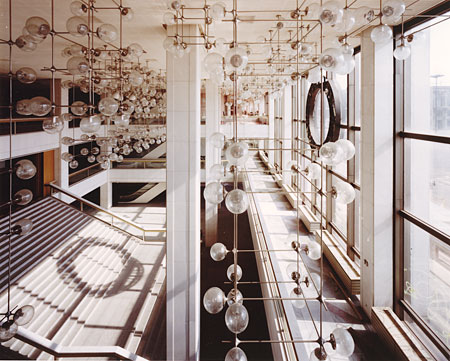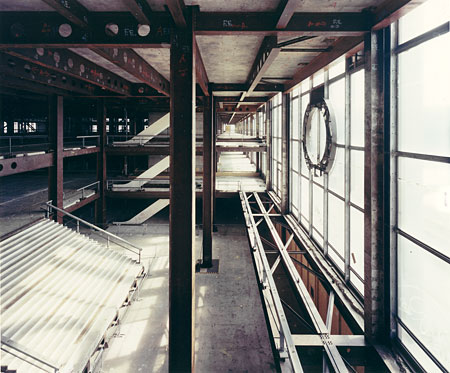This website uses cookies
This website uses cookies to enable it to function properly and to analyse how the website is used. Please click 'Close' to accept and continue using the website.




July 2006 - Palast der Republik, Berlin
(formerly Marx-Engels-Platz), 1974-6
Architects: Heinz Graffunder, Karl-Ernst Swora, Project architect: Erhardt Giesske, Artistic Director: Fritz Cremer
Text by Cordula Zeidler, photographs by Christian von Steffelin
The Palast der Republik (Palace of the Republic) in East Berlin’s centre is being demolished while I am writing this text. The Palast was one of East Germany’s most significant architectural projects. Its design history, its very short use and the discussion about its future reflect like no other building in the country the currents of East German politics. But the Palast’s fate also sheds light on attitudes of the reunified Germany towards the former GDR.
In 2002 it was decided by the German parliament that the Palast was to be demolished; for me who was born in East Germany this is a deep loss, which I think will deprive the younger generation of East Germans of an important means against which to test our identity. We were born in a country that no longer exists and it feels inappropriate that the built embodiments of our past are to be taken away before they have been studied, explored and assessed from a greater distance and with less emotional involvement than that of the generation of our parents.
But while I regret the demolition of the Palast, I also feel that Berlin in the past 16 years has seen one of the liveliest, most creative and intelligent debates about its past.
History
The Palast had been a project of the East German government and the Socialist party from as early as 1950, when the head of the new-born East German state, Walter Ulbricht, pushed a decision to demolish the war-damaged and burnt out castle, the Schloss. This building, dominating the centre of Berlin, was architecturally and historically significant, and had medieval roots and important Baroque elements. Its demolition was an ideologically inspired act of ignorance which was the result of a policy of a dogmatic regime that set out to eliminate Germany’s ‘imperialist’ past.
In the Schloss’ stead was to be built a monumental high-rise building to house the government. Along the lines of Soviet Russian architecture of the time, the design was to be stripped neo-Classical, or ‘Stalinist’. But while East German architects produced designs for this, time passed and money was needed to build housing, including the representative, again Soviet-inspired Stalinallee a mile or so east of the Schlossplatz. The Schlossplatz in turn remained a vast wasteland, not dissimilar for example to the area around the main station in the bombed city of Dresden that was only rebuilt in the mid 1960s.
Then East European architecture began to change from a representative, handcrafted monumentalism to a functional and stylistically modern idiom with an emphasis on fast production of accommodation, triggered by Nikita Khrushchev’s 1956 criticism of his predecessor Stalin. Designs of the 1960s for the new building in East Berlin’s centre became more structurally daring, including Herman Henselman’s dome and steel needle, a precursor of the Berlin TV tower.
But again the rebuilding focus shifted away from the former Schloss site, this time to Alexanderplatz, with a competition in 1964. It was not until Ulbricht was replaced by Erich Honecker as head of state in 1972 that the project was taken up again. Now the building programme was for a house of the people ( ‘Volkshaus’) and home for East German parliament (‘Volkskammer’). The project rapidly took shape. Architect Graffunder’s team designed a large elongated box made up of a steel frame and clad in a reflective glass envelope, into which were placed on the north site the auditorium of the Volkskammer and, at the south end, a large flexible conference space seating 5000. The interiors that also included bars and restaurants were lavishly detailed, and the wide, double-height foyer featured hundreds of lamps (which led to the Palast’s nickname of ‘Erich’s lamp shop’). The building was a success, not because it represented the state but because it offered amenities that were in very sort supply; restaurants in East Germany were few and far between.
The building was in use for a short fourteen years only, from 1976 to 1990. Swiftly after the East German Parliament had voted for the state to be dissolved in 1990, the Palast was closed due to asbestos contamination. The building was stripped back to its steel frame in 1998-9, ignoring advice by conservation experts to encase, rather than remove, the asbestos.
A future for the Palast?
The discussion about demolition or reuse has divided a city and its politicians. While the Berlin Senator for Culture, Thomas Flierl, son of the prominent East German architect Bruno Flierl, argued for its retention, the East German Social Democrat and Vice President of German parliament Wolfgang Thierse wanted to see the building demolished. And so did many Germans, in East and West, who think that with the end of state Socialism its traces must disappear too. But there were also countless voices that argued for the Palast to stay. The spaces within its large envelope could easily be converted, be it for much needed library space for the close-by Humboldt University or for cultural uses. A great number of artists have ‘re-used’ the building in the past four years or so, with installations and projects including the flooding of the building and boat tours.
But instead of developing a new building programme for the Palast, a new block on the footprint of the Schloss is to be rebuilt, featuring the lost historic facades. This was decided by parliament in 2002. But will a new building happen? Berlin is bankrupt, and the twelve million Euros that the Palast’s demolition will cost, plus the costs for the asbestos removal, have already proved expensive. So will Berlin end up with the largest wasteland in the centre of a European capital: an open space even wider than the former socialist square that was designed for state-controlled demonstrations? This would be a very ironic twist of history indeed.
While the Palast is disappearing, its architectural neighbours that enclosed the Schlossplatz have experienced very different fates. The Ministry of Foreign Affairs of 1966 was demolished in 1995 to make way for a still unrealised rebuilding of Schinkel’s 1836 Bauakademie, while the Staatsratsgebäude, a government building of 1964, has been listed and is now used as a private business school, complete with its original Socialist-Realist stained glass depicting the working classes. Meanwhile, samples of the Palast’s interior are dutifully being stored by Berlin’s conservation department; to be included in a future Schloss building that may, or may not, happen.
Look for past Buildings of the Month by entering the name of an individual building or architect or browsing the drop down list.

Become a C20 member today and help save our modern design heritage.